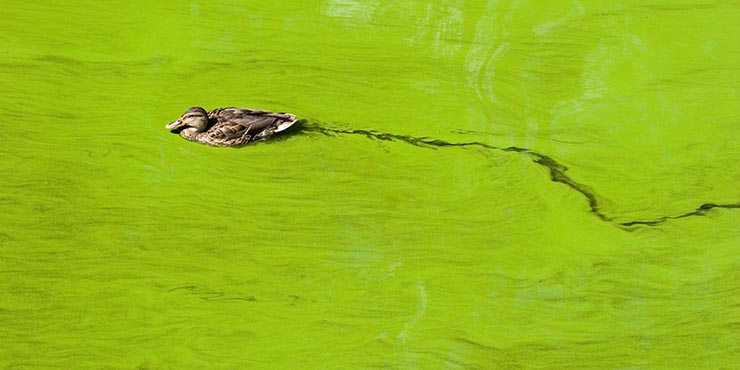Algal bloom in water body and precautionary measures to resolve

Do you know about algal bloom?
Algae are a class of organisms that are primarily aquatic, photosynthetic, and nucleus-bearing, but lack the true roots, stems, leaves, and specialized multicellular reproductive structures found in plants. Algal blooms are dense layers of tiny green plants that form on the surface of lakes and other bodies of water when nutrients (primarily phosphorus) are abundant. It can rapidly grow out of control, or “bloom,” when water is warm, slow-moving, and full of nutrients. Around the world, blooms can occur in fresh water, marine (salt) water, and brackish (a mixture of fresh and salt) water.
The majority of algae species, known as green algae and diatoms, are good algae that serve as a foundation food source for many aquatic organisms. Bad algae, also known as cyanobacteria, blue-green algae (BGA), or harmful algal blooms (HAB), are not a food source for aquatic organisms.
What are the reasons to create algal bloom?
Nutrient pollution that fuels algal blooms comes from a variety of sources, including agricultural and landscaping fertilizer runoff, leaky septic tanks and aging sewage infrastructure, and storm water runoff and urban runoff. Using phosphorus containing fertilizers and detergents enhance nutrient-rich runoff.
Higher summer temperatures and increased sunlight can also encourage algae blooms, as can standing water, which is warmer than circulating water and can act as an incubator, another important factor.
What are the problems arise because of HABs in waterbody?
In aquatic environments, algae play a variety of important and beneficial roles. They generate oxygen and consume CO2, serve as the foundation of the aquatic food chain, remove nutrients and pollutants from water, and stabilize sediments.
Toxins that kill fish and other animals are produced and released by HABs. Toxins produced by HABs can be harmful to humans and pose a risk to public health by lowering water quality or affecting people with respiratory conditions.
HABs can make drinking water unsafe. Furthermore, when water is contaminated with HABs, treating it becomes much more expensive and difficult. Even after it has been deemed safe to drink, the water may have an unpleasant odor or aftertaste.
Algae blooms can harm aquatic life by blocking out sunlight and clogging fish gills. It has the ability to create dead zones. These are areas of water with little to no oxygen in which aquatic life cannot survive.
While the beaches have become unfit for both animals and humans, businesses in the affected areas have suffered as well. Some countries’ economies are heavily reliant on tourism, and visitors are wisely changing their plans and staying away from the affected beaches.
How can you prevent HABs?
Algae are naturally occurring, but there is ample evidence that shows nutrient pollution can fuel blooms, making them larger and longer lasting. Worse, warming waters associated with climate change appear to be promoting the growth of these blooms in areas that have previously been unaffected by algae blooms.
You should take steps to reduce pollution sources and support clean water at the beach. Farmers can use landscaping techniques such as xeriscaping to increase groundwater filtration before water enters a pond or lake. Aerators and fountains can be used to introduce pond aeration and water movement. Rain barrels can be installed throughout the community to reduce polluted runoff. Around pond and lake banks, native vegetation should be used instead of cement banking or manicured lawns. Natural vegetation should be allowed to grow near the water’s edge. To reduce nutrient-rich runoff, use phosphorus-free fertilizers and detergents.
Not all algal blooms are harmful; in fact, some can be beneficial. Because phytoplankton is found at the bottom of the marine food chain, all other life in the ocean is dependent on it. Blooms can also be a good indicator of environmental change on land as well as in the water. Algae are the foundation of many aquatic food webs, fueling the growth of fish, insects, snails, and other organisms. This has significant implications for humans who enjoy recreation in aquatic systems and profit from aquatic products.
Farhana Islam
Agriculturist, Researcher
